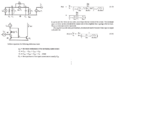mirror_pole
Member level 3
Hey guys,
I noticed that often the cap CDG is neglected in small signal analysis. especially if it connects 2 stages of an amplifier. Another example is if i want to calculate the transfer function of a current mirror, lets say the wide swing cascode mirror, i often see that CDG is getting neglected for simplicity.
I know that otherwise the calculation would become pretty complicated, but whats the reason i can neglect this cap? Is it because it is so small that poles or zeros associated with it wont affect the frequency behavior? What about the miller effect though. If i chose a low frequency mirror gain of lets say 10, is it still possible to neglect it ? Also if i apply miller theorem in this case i neglect a zero and the poles are uncoupled so i can assiciate them with nodes, which wont happen if i calculate the whole transfer function.
How accurate is this approximation and where is the limit? Or is it up to me to descide that with simulation results.
I noticed that often the cap CDG is neglected in small signal analysis. especially if it connects 2 stages of an amplifier. Another example is if i want to calculate the transfer function of a current mirror, lets say the wide swing cascode mirror, i often see that CDG is getting neglected for simplicity.
I know that otherwise the calculation would become pretty complicated, but whats the reason i can neglect this cap? Is it because it is so small that poles or zeros associated with it wont affect the frequency behavior? What about the miller effect though. If i chose a low frequency mirror gain of lets say 10, is it still possible to neglect it ? Also if i apply miller theorem in this case i neglect a zero and the poles are uncoupled so i can assiciate them with nodes, which wont happen if i calculate the whole transfer function.
How accurate is this approximation and where is the limit? Or is it up to me to descide that with simulation results.
Last edited:

